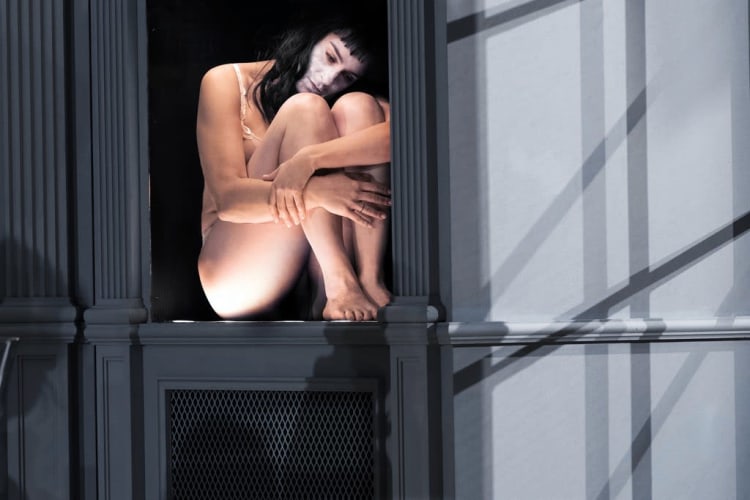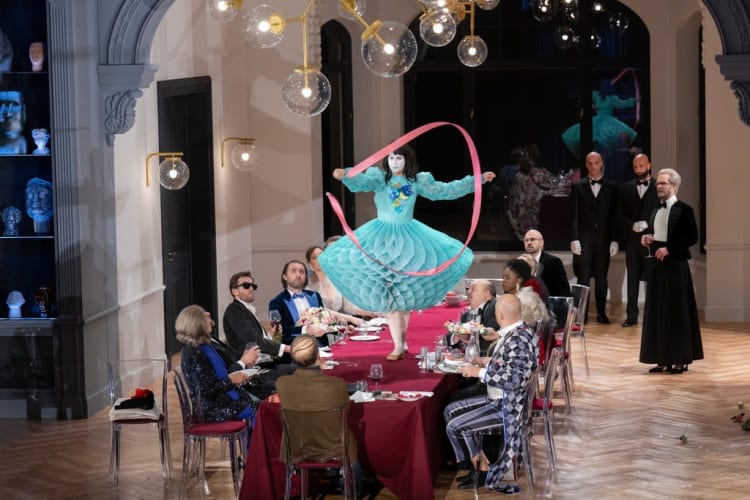Richard Strauss’s opera is based on Oscar Wilde’s play, which starred Sarah Bernhardt and was banned during rehearsal by the Lord Chamberlain, who refused a license because it depicted biblical characters. It did not get a professional performance until 1931.
Richard Strauss’s opera premièred in Dresden in 1905 and took thirty-eight curtain calls. The combination of Wilde’s pseudo-biblical shocker and Strauss’s dramatic, erotic score made for a heady, decadent, hysterical, vulgar, obscene mixture, which revolted many critics and audiences.
In Dmitri Tcherniakov’s production, conducted by Kent Nagano, the opera is no longer set in biblical times. The characters are updated to the bourgeoisie in the 20th century. We could be watching a film by Luis Buñuel. The whole action takes place round a long banquet table.
Herod, celebrating his birthday, looks like a slob who has never grown up. He wears a pink, floral-patterned suit. Lusty, comically absurd, he offers Salome, his step-daughter, half his kingdom, his wife’s jewellery and fifty peacocks if she will dance for him. There were times when John Daszak reminded me of Ricky Gervais playing David Brent in the television series The Office.
Asmik Grigorian’s Salome is not the sultry, sexy creature you might be hoping for, but a spoiled and surly brat, a stroppy teenager, an abused and deeply disturbed woman-child who is obsessed by Jochanaan’s voice, body and hair. When he refuses to kiss her on the mouth, she demands his severed head on a silver plate. She strips to her underwear, puts on a clown’s white face make-up and, rather than dance the Dance of the Seven Veils (a Wilde invention), she stomps around on chair and table, destroying anything within her reach. Grigorian is vocally phenomenal in her lengthy, taxing, frenetic, demented final aria.
Jochanaan is no longer in a deep underground prison cell; instead, he is permanently on stage, sitting at the banquet table with his back to the audience. Kyle Ketelsen does not look muscular enough to be the frightening prophet of doom; balding and wearing spectacles, he looks more like a university professor.
Violeta Urmana registers strongly as Herodias, Salome’s mother, who doesn’t like the rude things Jochaanan says about her and backs her daughter’s demand for his head. Narraboth, the Young Captain, wearing a white suit, comes across as out of his depth. In Oleksiy Palchykov’s performance, he is not so much in love with Salome as frightened as to what she will do next. The whole supporting cast, sitting at the banquet table, have been well chosen for their facial reactions.
Tchernaikov’s distinctive production is very watchable and I enjoyed it very much. The biggest surprise, however, for those who know the story, is that there is no severed head on stage for Salome to kiss and no Roman guards to crush her to death with their shields. She just drops down dead. Will anybody, except possibly Caravaggio and Beardsley, mind? I don’t think so.
Staatsoper Hamburg’s Salome can be watched free on the Arte Opera web site.


